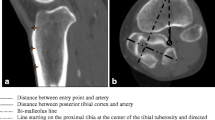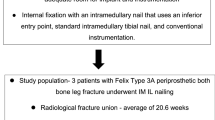Abstract
Purpose
To assess the risk of injury to the neurovascular bundle on the interosseous membrane of the leg during drilling for distal screw insertion in open-wedge high tibial osteotomy (OWHTO), and to investigate the possible influence of the method of plate placement on the risk.
Methods
This retrospective study involved, 55 patients (32 with a TomoFix plate, 23 with a TriS plate) who underwent postoperative CT scanning of the knee following OWHTO between 2009 and 2018. The angle and position of the locking plate, and the direction of screw insertion relative to the interosseous membrane were analysed.
Results
All distal screws had a risk of neurovascular injury. In particular, 25 screws at the #4 hole (45%) had an extended insertion trajectory that intersected with the interosseous membrane. The angle of the proximal part of the TomoFix plate was a significant risk factor. In contrast, methods of TriS plate placement showed no statistically significant differences.
Conclusions
Extended insertion trajectories of distal screws were likely to intersect with the interosseous membrane with the neurovascular bundle potentially on its surface; thus, drilling for bicortical fixation posed a risk of neurovascular injury. The risk increased as the TomoFix plate was placed more medially, suggesting that bicortical drilling must be performed with the utmost attention when the plate is placed at the medial position. Given the particularly high risk at the #3 and #4 screw holes, monocortical fixation of a few distal screws is recommended as long as good stability is ensured.






Similar content being viewed by others
References
Amis AA (2013) Biomechanics of high tibial osteotomy. Knee Surg Sports Traumatol Arthrosc 21:197–205
Boyce DA, Prewitt C (2018) Great toe drop following knee ligament reconstruction: a case report. Physiother Theory Pract 13:1–7
Dietrich P, Henning M (2013) The preclinical sheep model of high tibial osteotomy relating basic science to the clinics: standards, techniques and pitfalls. Knee Surg Sports Traumatol Arthrosc 21:228–236
Duivenvoorden T, van Diggele P, Reijman M et al (2017) Adverse events and survival after closing- and opening-wedge high tibial osteotomy: a comparative study of 412 patients. Knee Surg Sports Traumatol Arthrosc 25:895–901
Ekhtiari S, Haldane CE, de Sa D, Simunovic N, Musahl V, Ayeni OR (2016) Return to work and sport following high tibial osteotomy:a systematic review. J Bone Joint Surg Am 98:1568–1577
Emmanuel PE, Edgar MTE (2008) Isolated extensor hallucis longus paralysis after knee arthroscopy: a case report. Foot Ankle Online J 1(10):2
Fleorkemeier S, Staubli AE, Schroeter S, Goldhahn S, Lobenhoffer P (2013) Outcome after high tibial open-wedge osteotomy: a retrospective evaluation of 533 patients. Knee Surg Sports Traumatol Arthrosc 21:170–180
Fujisawa Y, Masuhara K, Shiomi S (1979) The effect of high tibial osteotomy on osteoarthritis of the knee. An arthroscopic study of 54 knee joints. Orthop Clin N Am 10:585–608
Georgoulis AD, Makris CA, Papageorgiou CD, Moebius UG, Xenakis T, Soucacos PN (1999) Nerve and vessel injuries during high tibial osteotomy combined with distal fibular osteotomy: a clinically relevant anatomic study. Knee Surg Sports Traumatol Arthrosc 7:15–19
Hey HW, Tan TC, Lahiri A et al (2011) Deep peroneal nerve entrapment by a spiral fibular fracture. J Bone Joint Surg Am 93:e113(1–5)
Ihle C, Ahrend M, Grunwald L, Ateschrang A, Stockle U, Schroter S (2017) No change in patellar height following open wedge high tibial osteotomy using a novel femur-referenced measurement method. Knee 24(5):1118–1128
Kihm CA, Camasta CA (2017) Review of drop hallux: assessment and surgical repair. J Foot Ankle Surg 56(1):103–107
Kudoh H, Sakai T, Horiguchi M (1999) The consistent presence of the human accessory deep peroneal nerve. J Anat 194:101–108
Lui TH, Chan LK (2011) Deep peroneal nerve injury following external fixation of the ankle: case report and anatomic study. Foot Ankle Int 32(5):550–555
Madry H, Goebel L, Hoffmann A et al (2017) Surgical anatomy of medial open-wedge high tibial osteotomy: crucial steps and pitfalls. Knee Surg Sports Traumatol Arthrosc 225(12):3661–3669
Martin R, Birmingham TB, Willits K, Litchfield R, Lebel ME, Giffin JR (2014) Adverse event rates and classifications in medial opening wedge high tibial osteotomy. Am J Sports Med 42(5):1118–1126
Ogawa H, Matsumoto K, Akiyama H (2017) The prevention of a lateral hinge fracture as a complication of a medial opening wedge high tibial osteotomy. Bone Joint J 99-B:887–893
Sabzevari S, Ebrahimpour A, Roudi MK, Kachooei AR (2016) High tibial osteotomy: a systematic review and current concept. Arch Bone Joint Surg 4(3):204–212
Seo SS, Kim OK, Seo JH, Kim DH, Kim YG, Lee IS (2016) Complications and short-term outcomes of medial opening wedge high tibial osteotomy using a locking plate for medial osteoarthritis of the knee. Knee Surg Relat Res 28(4):289–296
Shin YS, Kim KH, Sim HB, Yoon JR (2016) Comparison between two angular stable locking plates for medial opening-wedge high tibial osteotomy: decisive wedge locking plate versus TomoFix. J Orthop Sci 21(6):791–797
Staubli AE, Simoni CD, Babst R, Lobenhoffer P (2003) TomoFix: a new LCP-concept for open wedge osteotomy of the medial proximal tibia–early results in 92 cases. Injury 34:55–62
Suriyuth J, Viwatpinyo K, Phornphutkul C, Mahakkanukrauh P (2015) Anatomical relationship between the deep peroneal nerve and the anterolateral surface of the tibia in Thai cadavers. J Med Assoc Thai 98:207–211
Takeuchi R, Ishikawa H, Kumagai K et al (2012) Fractures around the lateral cortical hinge after a medial opening-wedge high tibial osteotomy: a new classification for lateral hinge fracture. Arthroscopy 28:85–94
Takeuchi R, Hwa JW, Ishikawa H et al (2017) Primary stability of different plate positions and the role of bone substitute in open wedge high tibial osteotomy. Knee 24(6):1299–1306
Funding
This study did not received any funding.
Author information
Authors and Affiliations
Corresponding author
Ethics declarations
Conflict of interest
Authors declares that they have no conflicts of interest.
Ethical approval
The study was approved by the ethics committee of Tokyo Women’s Medical University (Approval No. 4713).
Additional information
Publisher’s Note
Springer Nature remains neutral with regard to jurisdictional claims in published maps and institutional affiliations.
Rights and permissions
About this article
Cite this article
Itou, J., Itoh, M., Maruki, C. et al. Deep peroneal nerve has a potential risk of injury during open-wedge high tibial osteotomy. Knee Surg Sports Traumatol Arthrosc 28, 1372–1379 (2020). https://doi.org/10.1007/s00167-019-05445-y
Received:
Accepted:
Published:
Issue Date:
DOI: https://doi.org/10.1007/s00167-019-05445-y




